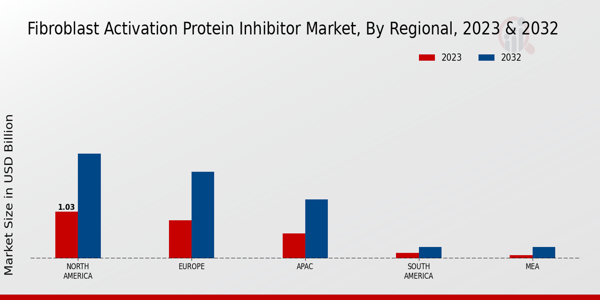Rising Prevalence of Cancer
The Global Fibroblast Activation Protein Inhibitor Market Industry is witnessing growth driven by the increasing incidence of cancer. Fibroblast activation protein inhibitors are being explored as potential therapeutic agents in oncology, particularly for solid tumors. As cancer cases rise, the demand for innovative treatments escalates. For instance, the World Health Organization reports that cancer cases are projected to reach 29.5 million by 2040. This trend suggests a growing market for fibroblast activation protein inhibitors, which could contribute to the market's valuation of 3.14 USD Billion in 2024 and potentially reach 8.72 USD Billion by 2035, with a CAGR of 9.73% from 2025 to 2035.
Advancements in Drug Development
Innovations in drug development methodologies are propelling the Global Fibroblast Activation Protein Inhibitor Market Industry forward. The integration of advanced technologies such as artificial intelligence and machine learning in drug discovery processes is enhancing the efficiency and accuracy of identifying potential inhibitors. These advancements facilitate the rapid progression of fibroblast activation protein inhibitors from preclinical to clinical stages. As a result, pharmaceutical companies are increasingly investing in research and development, which is likely to bolster the market's growth trajectory. The anticipated market value of 8.72 USD Billion by 2035 reflects the potential impact of these advancements on the industry.
Growing Investment in Oncology Research
The Global Fibroblast Activation Protein Inhibitor Market Industry is benefiting from heightened investment in oncology research. Governments and private entities are allocating substantial funds to explore novel cancer therapies, including fibroblast activation protein inhibitors. This influx of capital supports clinical trials and accelerates the development of innovative treatment options. For example, the National Cancer Institute has significantly increased its budget for cancer research initiatives, which is likely to enhance the pipeline of fibroblast activation protein inhibitors. As a result, the market is projected to expand, with a valuation of 3.14 USD Billion in 2024 and a potential growth to 8.72 USD Billion by 2035.
Increased Awareness of Targeted Therapies
There is a growing awareness among healthcare professionals and patients regarding the benefits of targeted therapies, which is positively influencing the Global Fibroblast Activation Protein Inhibitor Market Industry. Targeted therapies, including fibroblast activation protein inhibitors, offer more personalized treatment options with potentially fewer side effects compared to traditional chemotherapy. This shift in treatment paradigms is encouraging healthcare providers to adopt these innovative therapies, thereby increasing their market penetration. As the demand for targeted therapies rises, the market is expected to grow significantly, potentially reaching a valuation of 8.72 USD Billion by 2035.
Regulatory Support for Innovative Therapies
Regulatory bodies are increasingly supporting the development of innovative therapies, which is advantageous for the Global Fibroblast Activation Protein Inhibitor Market Industry. Initiatives aimed at expediting the approval process for novel drugs, particularly in oncology, are encouraging pharmaceutical companies to invest in fibroblast activation protein inhibitors. For instance, the FDA's Breakthrough Therapy Designation allows for faster development and review of drugs that show promise in treating serious conditions. This regulatory support is likely to enhance the market's growth potential, contributing to an expected valuation of 3.14 USD Billion in 2024 and a projected increase to 8.72 USD Billion by 2035.





















